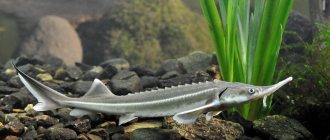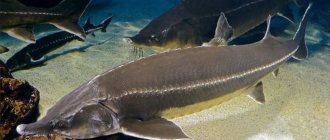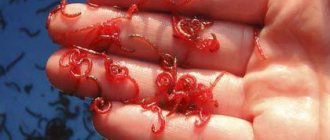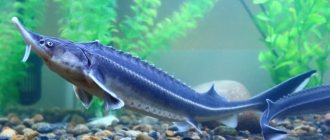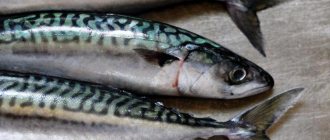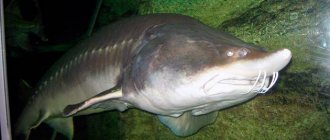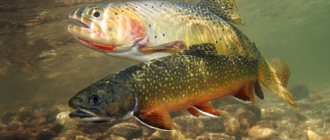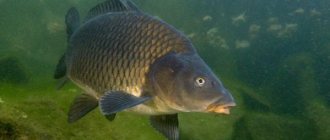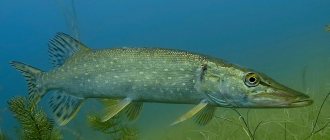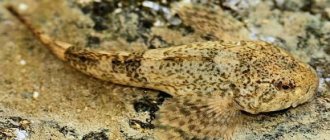Lenok
(from Latin Brachymystax) is a freshwater fish of the Salmon family, living in the foothills of rivers and cold mountain lakes. Distributed in rivers of the Far East and Siberia, Mongolia, China, and Western Korea. Recorded in large tributaries of the Yenisei - Sisima, Tube, Angara, Kane, Nizhnyaya Tunguska. In Russia, it lives in rivers from the Kolyma to the Ob, as well as in rivers that flow into the Sea of Japan and Okhotsk, for example, in the Amur.
Lenok is a fairly large freshwater fish. In the literature it is also called Siberian trout. Externally, lenok fish resembles salmon and whitefish. Her body is torpedo-shaped. Lenok's scales are quite small. The color is red-brown with different shades depending on the habitat. Lenok is a predator. The fish has a fairly small mouth. But at the same time, he is armed with teeth and fangs that will not miss even large prey. The average weight of an individual is about 2 kg, but some fish reach 8 kg. Lenok lives up to 14 years.
Description
Lenok
Kingdom:
animals (Animalia)
Phylum:
chordates (Chordata)
Class:
ray-finned fishes (Actinopterygii)
Order:
salmonids (Salmoniformes)
Family:
salmonids (Salmonidae)
Genus
lenok (Brachymystax)
Species:
lenok (Brachymystax lenok)
Lenok is a predatory freshwater fish from the salmon family. It also has other names: Siberian trout, limba (Yakut), maygun (Evenki) and uskuch (Turkic). It has 2 main forms: sharp-snouted and blunt-snouted. Externally, the body shape is a bit like a whitefish. The body is slab-shaped and has a small mouth, short sharp teeth and small dense scales. Reaches a length of 90 cm and a weight of 6.5 kg, the average dimensions correspond to a five-year-old individual and are 40 cm and 0.9 kg, respectively. Lives up to 15 years. The color of the lenka is determined by the age of the fish and its habitat conditions. The adult individual is dark brown and golden in color with many round dark spots, and the belly is light. During spawning, red spots appear. It has 2 fins on its back, both with spots. The lower front fins have a distinct white edge. A young immature lenok (hare) has a silver color, a gray back and yellowish fins. The law prohibits recreational and commercial fishing of hare.
There are two subspecies of lenok: blunt-snouted and sharp-snouted. Most likely, they were formed due to the preferred way of eating. The blunt-snout has a terminal mouth, which means it feeds in the middle layers of the reservoir. The sharp-snout has a slightly longer upper jaw and a semi-lower mouth, which means that it devotes some of its time to bottom feeding. The body of this fish is slanted, torpedo-shaped, with small scales, dark green at the back and dark golden or silver with small black spots on the sides. The tail has a small adipose fin, like all fish of the salmon family.
Lenka parking areas
“Siberian trout,” and this is what the common people call lenka, is found mainly near riffles, the main stream, current boundaries, in driftwood shelters, bays and holes. At the same time, like taimen, lenok does not stand in a fast flow. And in the heat, it seeks favorable coolness and a rich oxygen regime, so it can go out into the riffles or stick to the bottom.
These predators are distributed heterogeneously throughout the river. A large concentration of fish is observed in the upper reaches and in its middle reaches. And the lower down the river, the less lenka is found. This circumstance is associated with the location of spawning grounds, as well as with the diversity of untouched areas of mountain rivers.
The entry and exit zones of the riffles, as well as the boundaries of currents, are very promising for fishing. And if above the riffle there is a small channel that flows into the main channel below the riffle, then you will definitely find a lenka in it too.
Both in areas with riffles and in long stretches, lenok prefers to stay at the very edge of the shore - there the current is slower than on the main stream. The coastal zone itself usually contains depressions formed along the edge of the land. In addition, the area is strewn with stones that have rolled down from the hills. There are also trees on the shore with washed away roots or branches hanging over the water.
Lifestyle
The lifestyle of the lenka is reminiscent of the lifestyle of taimen and grayling.
Lenok, being a hare, stays in a flock in shallow reaches, in channels, rifts and bays, and the larger individual loves mountain rivers with deep reaches and rifts. The adult prefers solitary rather than gregarious life. Male flax reaches puberty at the age of 5-8 years, female – at 6-9 years. Reproduction occurs in May - June at a water temperature of 3-6 degrees Celsius in the upper reaches of large rivers and lakes, in springs and tributaries with a rocky bottom and a fast current 0.5-1.5 m from the water surface. After spawning, the lenok gradually slides downstream to deep areas, where it overwinters. Lenok fish
Lenok is sensitive to the oxygen state of the reservoir and loves clean, cold water.
Prefers to live in rivers with a medium current. With soil consisting of pebbles, stones or coarse sandstone. Loves lakes with flowing or semi-flowing water, with a decent food supply. Lives only in fresh water. Most active in the early morning and at sunset.
Description of freshwater fish lenok
The lenok fish lives in freshwater bodies of water and differs from its relatives in its bright color and the presence of black spots on its scales. Belongs to the order of predators. The mouth has sharp fangs and teeth, with the help of which it can easily cope with prey. Included in the salmon subspecies. Prefers to live in flocks, does not like a solitary lifestyle.
The individual is found in Siberia and the Far East, the North Caucasus; in large estuaries of large rivers (Volga, Lena, Ob, Kolyma, Yenisei). The weight of one fish is about 3 kg; larger species have been spotted - up to 8 kg. Life expectancy is up to 13 years.
Limba is 70 cm long and weighs up to 8 kg, prefers a solitary existence. Small fish live in schools. The growth rate is slow. During the spawning season, red spots appear on the sides and black spots on the fins. The photo shows that the specific color of the fish distinguishes the predator from the school.
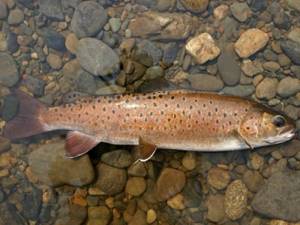
Spawning occurs in hard-to-reach places. Females release eggs in fast current conditions, at a depth of about 1 meter.
Nutrition
Lenok
- a predatory fish, juveniles first feed on zooplankton, then on small organisms living on the bottom. An older individual eats the larvae of various insects, these can be stoneflies, mayflies, caddisflies, dragonflies, grasshoppers, as well as algae, amphipods, small mollusks, earthworms, caviar and juveniles of other fish (minnow, minnow, sculpin, dace, perch and grayling ). Large individuals of lenok can even swallow a mouse, shrew or frog. Lenok feeds most actively in the mornings and evenings.
Lenka lifestyle
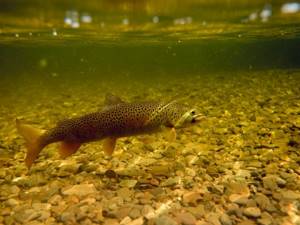
Lenok fish can live only in freshwater rivers and lakes. The main difference between lenka and salmon is that they are purely freshwater fish. This is not a migratory fish. “Siberian Trout” fully lives up to its name. The main condition: clean water, rich in oxygen and cool. In addition, lenkas need fast currents and numerous riffles.
Lenkas are born predators. The diet of “river leopards” consists of large and small fish, larvae, worms, mollusks, mosquitoes and beetles. Lenkas do not disdain rodents that accidentally find themselves in the river. Some fish enjoy hunting frogs. Lenok is a passionate predator. In the excitement of the hunt, he can approach the very shore and the prey; there is no hiding from him. He can hunt at any time of the day, but prefers dawn or sunset. At this time the fish are most active. Lenok is growing, and his gastronomic preferences are changing. If small lenkas feed on crustaceans and insects, then adult individuals will not disdain anything to satisfy their hunger.
Since lenok is a Siberian fish, it does not tolerate heat. Blessed coolness is what a predator needs for a comfortable existence. During the day, the lenok is not so active; it rests carefully near the underwater rocks and waits for the evening to start hunting. With the arrival of autumn, Lenkas become more active. They are looking for larger rivers. Small lenkas can gather in flocks of 20 individuals. Large representatives of the species go downstream in pairs. The fish are preparing for winter. They will survive the winter in warm holes and depressions.
Spawning
It reaches sexual maturity at 5-6 years of age. To reproduce, it goes to the upper reaches of rivers, enters streams and small clean channels. Selects a bottom with stones or pebbles, with a fairly strong current. This fish spawns at water temperatures from 3 to 7 degrees, almost always after the ice melts on reservoirs. The eggs are 3-4 mm in diameter, fertility ranges from 6 to 12 thousand eggs.
At this time, the color of the scales becomes more saturated and bright, reddish spots become visible, barely noticeable at other times. After spawning, the lenok remains in the same reservoir for feeding after a hunger strike. The young emerge from the eggs after a month, sometimes after a month and a half. After a month, the fry, which has grown to 2 cm, actively eats and by autumn moves to deeper places. In general, lenok grows quite slowly.
Nutrition and lifestyle
Lenkas prefer to feast on small fish, algae and plankton. It does not hesitate to feed on food waste, larvae, bugs and other representatives of the underwater kingdom. The diet may include food waste and soft weeds. Lenok spends the winter in pits, choosing places rich in food. The growth of individuals continues throughout their lives. Mainly found in bushes, deep holes, river depressions, under logs, and snags. Perfectly camouflaged under stones, merging with the bottom. Lenok looks bright, its variegated scales catch the eye of an experienced fisherman.
Fishing for lenka
Lenok fish
Lenka is caught after the end of spawning until late autumn at dawn and in the evenings. In the summer heat, the lenok moves chaotically and can accidentally swim into the mouth of a cold tributary, into a quiet backwater, or bay. In cool weather during the day, lenok gathers in reaches, holes and creases, and at night it feeds on riffles and channels, and is found in shallows near the shore.
On narrow rivers, lenok is usually caught from the bank with fly fishing, on wide rivers - with a spinning rod from a boat, and it is worth remembering that lenok usually lives next to taimen, a strong and large fish, so you need to choose strong tackle. It is better to select the nozzle and weight so that it moves near the bottom. The bait can be: pieces of fish, worms, insects and their larvae, as well as artificial bright sinking flies and spoons. Lenok prefers spinners that are oscillating, up to 55 mm long, up to 2.5 mm thick, triangular, weighing 20-30 grams, spinning up to 40 mm long. The hook should be large; treble hooks are placed with numbers 8,9 and 10, masking them with bright threads. Lenok is usually caught by the chin, because... tries to press the bait to the bottom of the reservoir. The fishing line is usually chosen with a thickness of 0.5-0.6 mm, a leash - 0.3-0.4 mm
The lenka bite is fast, like a trout. Fishing is quite troublesome - the lenok moves the line in different directions, jumps out of the water, somersaults and hides, so in order to avoid the lenok falling off the hook, fishermen try to go into the water in the shallows and bring the fish behind their backs. When the flax gets tired of fighting, they try to throw it further ashore. In a boat, the struggle looks about the same - we put the bit behind our back, lower it into the boat, take the fishing line with our hands and pull out the fish.
For a successful catch, the fisherman should take certain points into account. Firstly, lenok is a fairly cautious fish. Therefore, it makes no sense to catch it in one place for a long time. Feeling threatened, the lenok goes to another place. Secondly, once the fish is hooked, under no circumstances should it be allowed to go into the bushes. Otherwise, a breakdown of the lenka is inevitable. It is necessary that the line is always taut. There is no need to relax ahead of time. Even close to the shore, a lenok can break loose. But experienced fishermen know that this is not a fiasco at all. A tired fish lies motionless near the shore for some time. Therefore, with some skill, you can catch it with your hands.
Main fish habitats
Lenok fish is found in many rivers of Siberia, but the number of individuals of this species is not so large. So, in the west of Siberia there is quite a bit of it. In the Ob, the population is small due to illegal fishing. There are also few individuals in the Yenisei, its tributaries and rivers of the Pacific Ocean. Only on Sakhalin their numbers are quite high.
Outside Russia, lenok can be found in the rivers of Mongolia, North Korea, Kazakhstan and China. However, in all of the above places, fishing on an industrial scale is prohibited due to low populations. In some areas of the Krasnoyarsk Territory they tried to grow this type of fish on special farms.
Experts note that the decline in the number of this species is due to river pollution. Lenok is very picky about the composition of water. It cannot live in swampy bodies of water with standing water. He chooses shallow rivers with small rapids and fairly fast currents.
Fishermen say that not in all rivers where there is a population, it is possible to easily catch lenka: they are very careful. Individuals choose the upper reaches of rivers with medium flows. Large individuals live separately from their relatives. Only small fish gather in small schools. If there is an elm tree in the river, then luck may well smile on the fisherman.
Fishermen give several tips that will help while fishing. They believe that a person needs to be very careful, since the lenok acutely senses the presence of a person. If the fish gets scared, it will swim to another place. also important to prevent the fish from escaping into the bushes after it has swallowed the hook.
Composition and beneficial properties of lenka
Lenka meat contains essential fats and proteins, as well as vitamin PP, which has a beneficial effect on the nervous system, improves blood flow and helps eliminate toxins from the body. In addition, lenok contains a number of microelements: chromium, which accelerates metabolism and regulates blood glucose levels, zinc, necessary for the functioning of the gastrointestinal tract and kidneys, fluorine, which affects the condition of bone tissue, nails, hair and teeth, as well as molybdenum and nickel .
Lenok is a fish of the salmon family, so its caviar, although small, is very high in calories and contains a large amount of amino acids, which are easily absorbed in the body. This caviar contains almost the entire range of fat-soluble vitamins. Another advantage of this product is its easy and rapid absorption in the intestines, so it is recommended for use by weakened people who have suffered serious illnesses and surgeries and who cannot eat “heavy” foods.
Lenka meat has no obvious contraindications for consumption, however, people with individual intolerance to seafood and allergic reactions to fish should be extremely careful.
